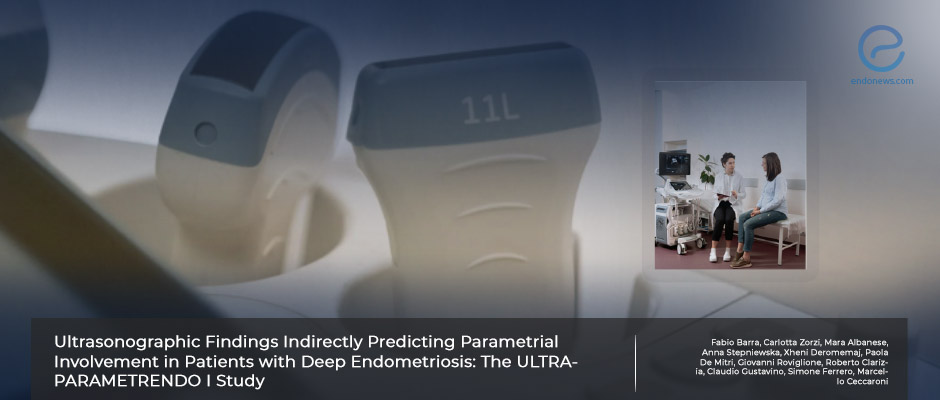Ultrasonographic findings predicting parametrial deep endometriosis
May 24, 2023
Some ultrasonographic signs and concomitant deep nodules should suggest parametrial endometriosis.
Key Points
Highlights:
- Suspected ultrasonographic signs of deep endometriosis are ovarian fixation to the lateral pelvic wall, the absence of anterior/posterior sliding, diffuse adenomyosis, multiple endometriomas, and hydronephrosis.
- When preoperative ultrasound findings suggest parametrial invasion, the patient has the chance to be referred to an expert center and receive appropriate treatment.
Importance:
- The gold standard for describing the presence of deep endometriosis is histologic confirmation after surgery.
What's done here:
- This study was designed to evaluate the preoperative ultrasonographic findings as a first-line imaging tool to predict the presence of deep endometriosis.
- A retrospective analysis of a database prospectively collected from consecutive patients undergoing laparoscopic deep endometriosis surgery in a tertiary center was performed.
- Aim was to propose the best prediction model for indirectly diagnosing parametrial deep endometriosis at the preoperative ultrasound.
- The demographic characteristics, usage of hormonal therapies, and ultrasonographic and surgical findings of the study population were statistically evaluated.
Key Results:
- Definitive analyses were performed on 1079 of 1183 patients who met the criteria and were referred with a suspicion of deep endometriosis necessitating surgical intervention.
- The presence of parametrial endometriosis at surgery was detected in 212 patients who had ultrasonographic indirect deep endometriosis signs with concomitant nodules.
- The prediction model obtained for parametrial involvement included the presence of hydronephrosis, the complete absence of a posterior sliding sign, the presence of multiple endometriomas per ovary, and ovarian fixation to the uterine wall.
- The concomitant nodules were uterosacral nodules of >10 mm in diameter, rectal endometriosis with the largest diameter of >25 mm, and rectovaginal septum infiltration.
- The study showed that predicting parametrial involvement depends on the ultrasonographical presence of at least 2 concomitant deep nodules and at least 1 indirect deep endometriosis sign, with a sensitivity and specificity of 78,8% and 72,3%.
Lay Summary
Transvaginal ultrasonographic evaluation is the primary imaging technique to rule out deep endometriosis. Although the International Deep Endometriosis Analysis Group (IDEA) published a consensus to standardize the nomenclature of ultrasonographic pelvic examination in women with suspected deep endometriosis, parametrial deep endometriosis has not been described and classified.
Only a few studies that detected the accuracy of Transvaginal Ultrasonography examination for parametrial endometriosis mentioned some indirect signs that correlated deep endometriosis presence, such as uterine adenomyosis, ovarian endometriomas with "kissing ovaries" sign, and the fixation of the ovary to the uterine wall. In addition, it is known that the absence of a sliding sign has been strongly associated with Douglas pouch obliteration and rectosigmoid endometriosis in laparoscopy.
Dr. Barra et al. from the Department of Obstetrics and Gynecology and Minimally Pelvic Surgery at the University of Genoa, Italy, set up a study aiming to identify ultrasonographic findings of deep parametrial endometriosis to build a preoperative model for prediction. Evaluation and statistical analyses were done on the data of 1079 consecutive women who were addressed to their tertiary institution. All patients underwent laparoscopic surgery within 15 days of the ultrasonographic examinations performed by 4 experienced operators. Evaluation of concomitant nodules was done according to IDEA criteria. Deep endometriosis signs were also systematically investigated by following the first three steps of IDEA consensus.
The surgeons' team that was consisted of experienced gynecologists, urologists, and colorectal surgeons evaluated the ultrasonography images and reports before the laparoscopy. The severity of the disease was classified according to rASRM. The presence of parametrial endometriosis is described as deep endometriosis nodules in the anterior, posterior, and lateral parametrium which eventually need partial or total radical parametrectomy. The nodules were histopathologically confirmed as endometriosis.
During the surgery, no parametrial invasion was found in 866 patients, while 212 had parametrial deep endometriosis. When the ultrasonographic findings were evaluated, deep endometriosis nodules on the rectum and uterosacral ligaments were the most prominent ones predicting parametrial invasion. Multiple endometriomas, ovarian fixation to the uterine wall and uterosacral ligaments, and absence of posterior sliding sign were remarkable. However, when considering singularly every ultrasonographic finding, none of them is in the final model to demonstrate a relevant sensitivity for the prediction of the presence of parametrial deep endometriosis.
The authors mentioned that the possibility to indirectly suspect parametrial invasion may be relevant to address patients to expert leading centers, for proper diagnosis and surgical treatment. This paper was published in the January 2023 issue of the Journal of Minimally Invasive Gynecology.
Research Source: https://pubmed.ncbi.nlm.nih.gov/36591808/
ultrasound laparoscopy parametrial endometriosis deep endometriosis prediction

